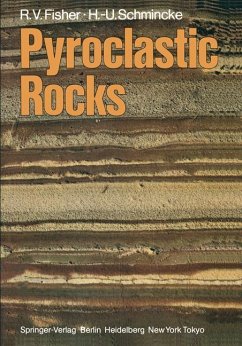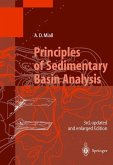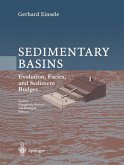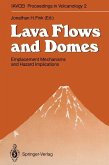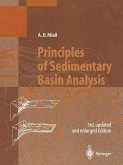- Broschiertes Buch
- Merkliste
- Auf die Merkliste
- Bewerten Bewerten
- Teilen
- Produkt teilen
- Produkterinnerung
- Produkterinnerung
Pyroclastic Rocks is the first modern comprehensive treatment of what they are and how they were formed. The subject is discussed against a background of plate tectonics theory and modern advances in volcanology, sedimentology and igneous petrology. The book provides a thorough discussion of magmatic volatiles and pyroclastic processes as well as magma-water interactions. Most of the book is concerned with the wide spectrum of pyroclastic rocks formed on land and under water and by fallout and various flowage mechanisms. Diagenetic processes by which pyroclastic particles are transformed into…mehr
Andere Kunden interessierten sich auch für
![Principles of Sedimentary Basin Analysis Principles of Sedimentary Basin Analysis]() Andrew D. MiallPrinciples of Sedimentary Basin Analysis167,99 €
Andrew D. MiallPrinciples of Sedimentary Basin Analysis167,99 €![Sedimentary Basins Sedimentary Basins]() Gerhard EinseleSedimentary Basins90,94 €
Gerhard EinseleSedimentary Basins90,94 €![Lava Flows and Domes Lava Flows and Domes]() Lava Flows and Domes39,99 €
Lava Flows and Domes39,99 €![Principles of Sedimentary Basin Analysis Principles of Sedimentary Basin Analysis]() Andrew D. MiallPrinciples of Sedimentary Basin Analysis115,99 €
Andrew D. MiallPrinciples of Sedimentary Basin Analysis115,99 €![Pre-Mesozoic Geology in the Alps Pre-Mesozoic Geology in the Alps]() Pre-Mesozoic Geology in the Alps79,99 €
Pre-Mesozoic Geology in the Alps79,99 €![Chemical Transport in Metasomatic Processes Chemical Transport in Metasomatic Processes]() Harold C. Helgeson (ed.)Chemical Transport in Metasomatic Processes107,99 €
Harold C. Helgeson (ed.)Chemical Transport in Metasomatic Processes107,99 €![Chemical Transport in Metasomatic Processes Chemical Transport in Metasomatic Processes]() Chemical Transport in Metasomatic Processes39,99 €
Chemical Transport in Metasomatic Processes39,99 €-
-
-
Pyroclastic Rocks is the first modern comprehensive treatment of what they are and how they were formed. The subject is discussed against a background of plate tectonics theory and modern advances in volcanology, sedimentology and igneous petrology. The book provides a thorough discussion of magmatic volatiles and pyroclastic processes as well as magma-water interactions. Most of the book is concerned with the wide spectrum of pyroclastic rocks formed on land and under water and by fallout and various flowage mechanisms. Diagenetic processes by which pyroclastic particles are transformed into rocks are discussed in detail. The stratigraphic and tectonic importance of pyroclastic rocks are illustrated using selected case histories. This uniquely integrated account of pyroclastic processes, particles and rocks will prove a valuable aid in reconstructing dynamic aspects of earth evolution as well as predicting future volcanic hazards; understanding sedimentary basins containing petroleum and gas deposits; locating ore deposits in volcanic complexes and heat sources in geothermal prospecting; and facilitating stratigraphic analysis in complex volcanic terrains.
Produktdetails
- Produktdetails
- Verlag: Springer / Springer Berlin Heidelberg / Springer, Berlin
- Artikelnr. des Verlages: 978-3-540-51341-4
- 1984.
- Seitenzahl: 488
- Erscheinungstermin: 10. August 1989
- Englisch
- Abmessung: 244mm x 170mm x 27mm
- Gewicht: 914g
- ISBN-13: 9783540513414
- ISBN-10: 3540513418
- Artikelnr.: 27978949
- Verlag: Springer / Springer Berlin Heidelberg / Springer, Berlin
- Artikelnr. des Verlages: 978-3-540-51341-4
- 1984.
- Seitenzahl: 488
- Erscheinungstermin: 10. August 1989
- Englisch
- Abmessung: 244mm x 170mm x 27mm
- Gewicht: 914g
- ISBN-13: 9783540513414
- ISBN-10: 3540513418
- Artikelnr.: 27978949
Hans-Ulrich Schmincke war von 1983-91 Generalsekretär der International Association of Volcanology und war Direktor der Abteilung Vulkanologie und Petrologie am Geomar-Forschungszentrum in Kiel. Er hat zahlreiche nationale und internationale Auszeichnungen erhalten, darunter den höchsten deutschen Wissenschaftspreis, den Leibniz-Preis der Deutschen Forschungsgemeinschaft.
1 Introduction.- The Sedimentary Record: Volcanic Contribution.- Chemical Composition of Tephra.- Types of Pyroclastic Accumulations.- 2 Volcanoes, Volcanic Rocks and Magma Chambers.- Tectonic Setting of Volcanoes.- Divergent Margins.- Convergent Margins.- Intraplate Volcanoes.- Form of Volcanoes.- Origin of Magmas and Classification of Volcanic Rocks.- Basaltic Magmas.- Basalts.- Andesite-Suite Magmas.- Andesites.- Differentiated Magmas.- Magma Chambers.- Volumes of Magma Chambers.- Zonation in Magma Chambers.- Large Calcalkalic Systems.- Small Highly Alkalic Systems.- Oceanic Rhyolite-Basalt Systems.- Very Small Mafic-Intermediate Magma Systems.- 3 Magmatic Volatiles and Rheology.- Volatiles.- Methods of Determining Volatiles.- Composition and Amount of Volatiles.- Water 38 - Carbon Dioxide 43 - Sulfur.- Volatile Distribution in Magma Columns.- Rheology.- Viscosity.- Vesiculation.- 4 Explosive Volcanic Eruptions.- Types of Volcanic Activity.- Types of Eruptions.- Pyroclastic Eruptive Systems.- Eruption Columns.- Plinian Eruptions and Eruption Columns.- Hawaiian and Strombolian Eruptions.- Observations 69 - Eruptive Mechanisms.- Hydroclastic Eruptive Processes.- Formation of Glassy Pyroclasts.- Granulation.- Inhibition of Vesiculation.- Transfer of Heat.- Steam Eruptions.- Magma-Water Mixing and Fuel-Coolant Interaction.- Phreatic and Phreatomagmatic (Vulcanian) Eruptions.- Volcanic Energy.- 5 Pyroclastic Fragments and Deposits.- General Components.- Vitric Particles and Pyrogenic Crystals.- Glass Shards.- Shards Formed by Vesiculation.- Pumice.- Pyrogenic Minerals.- Surface Textures of Minerals and Shards.- Structure.- Pyroclastic Bed or Stratum.- Graded Bedding.- Cross Bedding.- Massive Beds.- Alignment and Orientation Bedding.- Penecontemporaneous Deformation Structures.- Texture.- Grain Size and Size Distribution.- Distribution Curves.- Shape and Roundness.- Fabric.- 6 Subaerial Fallout Tephra.- Components of Subaerial Fallout.- Areal Distribution.- Distribution and Thickness.- Volume.- Structures.- Bedding.- Mantle Bedding.- Graded Bedding.- Fabric.- Size Parameters.- Maximum Size of Components.- Median Diameter.- Grain-Size Distribution (Sorting).- Eolian Fractionation.- 7 Submarine Fallout Tephra from Subaerial Eruptions.- Chemical Composition.- Structures of Submarine and Lacustrine Ash Layers.- Areal Thickness Distribution and Volume.- Grain Size and Sorting.- Regional Distribution and Tephrochronology.- Source.- Correlation and Age.- Pacific Region.- Atlantic Region.- 8 Pyroclastic Flow Deposits.- Historic Development of Concepts.- The Deposits.- Volume.- Relationship to Topography.- Flow Units and Cooling Units.- Components.- Primary Structures in Unwelded Deposits.- Internal Layering 198 - Gas-Escape Structures.- Emplacement Facies.- Texture.- Pyroclastic Flow Deposits 207 - Pyroclastic Surge Deposits 208 - Segregation of Crystals and Lithics.- Chemical Composition.- Temperature Effects.- Measured Temperatures 210 Inferred Temperatures 211 - Welding and Compaction 213 - Structures Related to Temperature and Viscosity.- Thermoremanent Magnetism.- Classification and Nomenclature.- The Flows.- Origin.- Transport and Mobility.- Tufolavas, Froth Flows, Foam Lavas and Globule Flows.- Ignimbrite Vents: Speculation.- 9 Deposits of Hydroclastic Eruptions.- Definition of Terms.- Components of Hydroclastic Deposits.- Grain Size Distribution.- Characteristics of Essential Components.- Accretionary Lapilli.- Accidental Clasts.- Maximum Size of Fragments Related to Energetics.- Ultramafic Xenoliths.- Structures.- Penecontemporaneous Soft Sediment Deformation.- Vesicles (Gas Bubbles).- Bedding Sags.- Mudcracks.- Base Surge Deposits.- Bed Forms from Base Surges.- Sandwave Beds 250 - Plane-Parallel Beds 254 - Massive Beds.- Bed Form Facies.- U-Shaped Channels.- Maar Volcanoes.- Classification.- Origin.- Dimensions.- Areal Extent and Geometry 260 - Volume.- Chemical Composition.- Littoral Cones.- Deposits.- Origin.- Peperites.- 10 Submarine Volcaniclastic Rocks.- Deep Water Stage.- Pillow Breccias.- Fine-grained Hyaloclastites.- Shoaling Submarine Volcano.- Transition Submarine - Subaerial.- Volcaniclastic Aprons.- Silicic Submarine Eruptions.- Subaqueous Pyroclastic Flows.- Terminology.- Nonwelded Deposits.- Environment of Deposition.- Components.- Grain Size, Sorting and Fabric.- Bedding and Grading.- The Massive Lower Division 289 - Upper Division.- Relationship to Eruptions and Eruptive Centers.- Welded Deposits.- Discussion.- 11 Lahars.- Debris Flows as Fluids.- Distribution and Thickness.- Surface of Lahars.- Basal Contact of Lahars.- Components of Lahars.- Grain-Size Distribution.- Vesicles.- Grading.- Fabric.- Comparison of Lahars with Other Kinds of Coarse-Grained Deposits.- Origin.- 12 Alteration of Volcanic Glass.- Diagenesis.- Alteration of Basaltic Glass.- Palagonite.- Physical Properties 315 - Textural Changes 315 - Mineralogical Changes 317 - Zeolites 318 - Chemical Changes.- Process of Palagonite Formation.- Rate of Palagonitization.- Alteration of Silicic Glass.- Hydration and Ion Exchange.- Advanced Stages of Alteration.- Saline Alkaline Lake Environment.- Marine Environment.- Bentonites and Tonsteins.- Burial Diagenesis and Metamorphism.- 13 Stratigraphic Problems of Pyroclastic Rocks.- Relation of Volcanic Activity to Rock Stratigraphy.- Volcanic Activity Units.- Eruption Unit.- Stratigraphic Problems in Young Volcanic Terranes.- Stratigraphic Nomenclature in Older Volcanic Terranes.- Tephrochronology.- Volcanic Facies.- Facies Based upon Position Relative to Source.- Near-Source Facies 358 - Intermediate-Source Facies 359 - Distant-Source Facies 359 - Caldera Facies.- Facies Based upon Environment of Deposition.- Facies Based upon Primary Composition.- Compositional Facies 362 - Petrofacies.- Diagenetic Rock Facies.- Stratigraphic Examples.- Oshima Volcano, Japan.- San Juan Volcanic Field, USA.- Archean Greenstone-Belt Volcanoes, Canada.- 14 Pyroclastic Rocks and Tectonic Environment.- Convergent Margins, Magmatic Arcs, and Sedimentation.- The Trench.- Fore-Arc and Back-Arc Basins.- The Cordilleran System.- Western North America: Paleozoic Rocks 392 - Southern South America: Upper Mesozoic Flysch 396 - Cenozoic Tectonism and Volcanism: Western North America.- Oceanic Island Arc Settings.- Volcaniclastic Rocks and Facies; Cenozoic 400 - Lau Basin and Tonga Arc 405 - Lesser Antilles Arc.- The Pre-Cambrian.- References.- Locality Index.
1 Introduction.- The Sedimentary Record: Volcanic Contribution.- Chemical Composition of Tephra.- Types of Pyroclastic Accumulations.- 2 Volcanoes, Volcanic Rocks and Magma Chambers.- Tectonic Setting of Volcanoes.- Divergent Margins.- Convergent Margins.- Intraplate Volcanoes.- Form of Volcanoes.- Origin of Magmas and Classification of Volcanic Rocks.- Basaltic Magmas.- Basalts.- Andesite-Suite Magmas.- Andesites.- Differentiated Magmas.- Magma Chambers.- Volumes of Magma Chambers.- Zonation in Magma Chambers.- Large Calcalkalic Systems.- Small Highly Alkalic Systems.- Oceanic Rhyolite-Basalt Systems.- Very Small Mafic-Intermediate Magma Systems.- 3 Magmatic Volatiles and Rheology.- Volatiles.- Methods of Determining Volatiles.- Composition and Amount of Volatiles.- Water 38 - Carbon Dioxide 43 - Sulfur.- Volatile Distribution in Magma Columns.- Rheology.- Viscosity.- Vesiculation.- 4 Explosive Volcanic Eruptions.- Types of Volcanic Activity.- Types of Eruptions.- Pyroclastic Eruptive Systems.- Eruption Columns.- Plinian Eruptions and Eruption Columns.- Hawaiian and Strombolian Eruptions.- Observations 69 - Eruptive Mechanisms.- Hydroclastic Eruptive Processes.- Formation of Glassy Pyroclasts.- Granulation.- Inhibition of Vesiculation.- Transfer of Heat.- Steam Eruptions.- Magma-Water Mixing and Fuel-Coolant Interaction.- Phreatic and Phreatomagmatic (Vulcanian) Eruptions.- Volcanic Energy.- 5 Pyroclastic Fragments and Deposits.- General Components.- Vitric Particles and Pyrogenic Crystals.- Glass Shards.- Shards Formed by Vesiculation.- Pumice.- Pyrogenic Minerals.- Surface Textures of Minerals and Shards.- Structure.- Pyroclastic Bed or Stratum.- Graded Bedding.- Cross Bedding.- Massive Beds.- Alignment and Orientation Bedding.- Penecontemporaneous Deformation Structures.- Texture.- Grain Size and Size Distribution.- Distribution Curves.- Shape and Roundness.- Fabric.- 6 Subaerial Fallout Tephra.- Components of Subaerial Fallout.- Areal Distribution.- Distribution and Thickness.- Volume.- Structures.- Bedding.- Mantle Bedding.- Graded Bedding.- Fabric.- Size Parameters.- Maximum Size of Components.- Median Diameter.- Grain-Size Distribution (Sorting).- Eolian Fractionation.- 7 Submarine Fallout Tephra from Subaerial Eruptions.- Chemical Composition.- Structures of Submarine and Lacustrine Ash Layers.- Areal Thickness Distribution and Volume.- Grain Size and Sorting.- Regional Distribution and Tephrochronology.- Source.- Correlation and Age.- Pacific Region.- Atlantic Region.- 8 Pyroclastic Flow Deposits.- Historic Development of Concepts.- The Deposits.- Volume.- Relationship to Topography.- Flow Units and Cooling Units.- Components.- Primary Structures in Unwelded Deposits.- Internal Layering 198 - Gas-Escape Structures.- Emplacement Facies.- Texture.- Pyroclastic Flow Deposits 207 - Pyroclastic Surge Deposits 208 - Segregation of Crystals and Lithics.- Chemical Composition.- Temperature Effects.- Measured Temperatures 210 Inferred Temperatures 211 - Welding and Compaction 213 - Structures Related to Temperature and Viscosity.- Thermoremanent Magnetism.- Classification and Nomenclature.- The Flows.- Origin.- Transport and Mobility.- Tufolavas, Froth Flows, Foam Lavas and Globule Flows.- Ignimbrite Vents: Speculation.- 9 Deposits of Hydroclastic Eruptions.- Definition of Terms.- Components of Hydroclastic Deposits.- Grain Size Distribution.- Characteristics of Essential Components.- Accretionary Lapilli.- Accidental Clasts.- Maximum Size of Fragments Related to Energetics.- Ultramafic Xenoliths.- Structures.- Penecontemporaneous Soft Sediment Deformation.- Vesicles (Gas Bubbles).- Bedding Sags.- Mudcracks.- Base Surge Deposits.- Bed Forms from Base Surges.- Sandwave Beds 250 - Plane-Parallel Beds 254 - Massive Beds.- Bed Form Facies.- U-Shaped Channels.- Maar Volcanoes.- Classification.- Origin.- Dimensions.- Areal Extent and Geometry 260 - Volume.- Chemical Composition.- Littoral Cones.- Deposits.- Origin.- Peperites.- 10 Submarine Volcaniclastic Rocks.- Deep Water Stage.- Pillow Breccias.- Fine-grained Hyaloclastites.- Shoaling Submarine Volcano.- Transition Submarine - Subaerial.- Volcaniclastic Aprons.- Silicic Submarine Eruptions.- Subaqueous Pyroclastic Flows.- Terminology.- Nonwelded Deposits.- Environment of Deposition.- Components.- Grain Size, Sorting and Fabric.- Bedding and Grading.- The Massive Lower Division 289 - Upper Division.- Relationship to Eruptions and Eruptive Centers.- Welded Deposits.- Discussion.- 11 Lahars.- Debris Flows as Fluids.- Distribution and Thickness.- Surface of Lahars.- Basal Contact of Lahars.- Components of Lahars.- Grain-Size Distribution.- Vesicles.- Grading.- Fabric.- Comparison of Lahars with Other Kinds of Coarse-Grained Deposits.- Origin.- 12 Alteration of Volcanic Glass.- Diagenesis.- Alteration of Basaltic Glass.- Palagonite.- Physical Properties 315 - Textural Changes 315 - Mineralogical Changes 317 - Zeolites 318 - Chemical Changes.- Process of Palagonite Formation.- Rate of Palagonitization.- Alteration of Silicic Glass.- Hydration and Ion Exchange.- Advanced Stages of Alteration.- Saline Alkaline Lake Environment.- Marine Environment.- Bentonites and Tonsteins.- Burial Diagenesis and Metamorphism.- 13 Stratigraphic Problems of Pyroclastic Rocks.- Relation of Volcanic Activity to Rock Stratigraphy.- Volcanic Activity Units.- Eruption Unit.- Stratigraphic Problems in Young Volcanic Terranes.- Stratigraphic Nomenclature in Older Volcanic Terranes.- Tephrochronology.- Volcanic Facies.- Facies Based upon Position Relative to Source.- Near-Source Facies 358 - Intermediate-Source Facies 359 - Distant-Source Facies 359 - Caldera Facies.- Facies Based upon Environment of Deposition.- Facies Based upon Primary Composition.- Compositional Facies 362 - Petrofacies.- Diagenetic Rock Facies.- Stratigraphic Examples.- Oshima Volcano, Japan.- San Juan Volcanic Field, USA.- Archean Greenstone-Belt Volcanoes, Canada.- 14 Pyroclastic Rocks and Tectonic Environment.- Convergent Margins, Magmatic Arcs, and Sedimentation.- The Trench.- Fore-Arc and Back-Arc Basins.- The Cordilleran System.- Western North America: Paleozoic Rocks 392 - Southern South America: Upper Mesozoic Flysch 396 - Cenozoic Tectonism and Volcanism: Western North America.- Oceanic Island Arc Settings.- Volcaniclastic Rocks and Facies; Cenozoic 400 - Lau Basin and Tonga Arc 405 - Lesser Antilles Arc.- The Pre-Cambrian.- References.- Locality Index.

